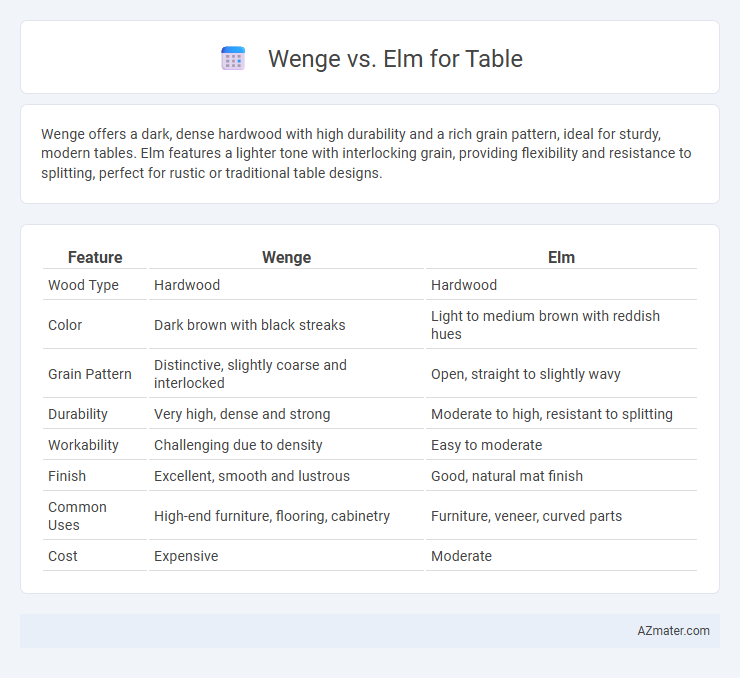Wenge offers a dark, dense hardwood with high durability and a rich grain pattern, ideal for sturdy, modern tables. Elm features a lighter tone with interlocking grain, providing flexibility and resistance to splitting, perfect for rustic or traditional table designs.
Table of Comparison
| Feature | Wenge | Elm |
|---|---|---|
| Wood Type | Hardwood | Hardwood |
| Color | Dark brown with black streaks | Light to medium brown with reddish hues |
| Grain Pattern | Distinctive, slightly coarse and interlocked | Open, straight to slightly wavy |
| Durability | Very high, dense and strong | Moderate to high, resistant to splitting |
| Workability | Challenging due to density | Easy to moderate |
| Finish | Excellent, smooth and lustrous | Good, natural mat finish |
| Common Uses | High-end furniture, flooring, cabinetry | Furniture, veneer, curved parts |
| Cost | Expensive | Moderate |
Introduction to Wenge and Elm Wood
Wenge wood, prized for its deep, rich chocolate-brown color with black streaks, offers exceptional durability and a dense texture ideal for luxurious tables. Elm wood features a warm, golden-brown hue with intricate grain patterns, known for its flexibility and resistance to splitting, making it a favored choice for elegant, resilient furniture. Both woods provide unique aesthetic qualities and functional advantages, with Wenge excelling in hardness and Elm notable for shock resistance.
Origin and Botanical Profile
Wenge (Millettia laurentii) is a tropical hardwood native to Central Africa, prized for its dark brown to black coloration and dense, durable grain, making it ideal for high-end furniture like tables. Elm (Ulmus spp.), originating from temperate regions of the Northern Hemisphere including North America, Europe, and Asia, features a coarse texture with an interlocking grain that offers flexibility and resistance to splitting. Both woods provide distinct aesthetic and structural qualities influenced by their geographic origin and botanical characteristics, with Wenge's high density contrasting Elm's moderate hardness and resilience.
Appearance and Color Comparison
Wenge features a rich, dark brown to almost black color with fine, closely spaced grain patterns, creating a bold and dramatic look ideal for modern or luxurious tables. Elm offers a lighter, warm hue ranging from golden brown to reddish tones, showcasing a unique, interlocking grain that adds visual interest and a rustic charm. The stark contrast in color depth and grain texture between Wenge and Elm allows for distinct aesthetic choices depending on the desired style and ambiance of the table.
Grain Patterns and Texture
Wenge wood features a dramatic, dark brown to black coloration with tightly interlocked grain patterns that create a striking, coarse texture ideal for bold, modern tables. Elm offers a more subtle, lighter brown hue with open, flowing grain patterns and a moderately coarse texture that enhances natural warmth and rustic appeal in tabletops. The dense, heavy texture of wenge contrasts sharply with the softer, more elastic properties of elm, affecting both the tactile feel and finish quality of table surfaces.
Durability and Strength
Wenge wood is renowned for its exceptional durability and high density, making it highly resistant to scratches, dents, and wear, which supports long-lasting table surfaces in heavy-use environments. Elm, while also durable, has a slightly lower hardness rating, offering moderate resistance to impact and wear but is valued for its flexibility and resistance to splitting. For tables requiring maximum strength and durability, Wenge is the preferred choice, whereas Elm provides a balance of sturdiness and workability.
Workability and Ease of Crafting
Wenge offers a dense, hard texture that makes it highly durable but challenging to work with, often requiring sharp tools and careful handling to avoid splintering and dulling blades. Elm, in contrast, features a moderately hard but more elastic grain that allows for easier carving, shaping, and sanding while resisting cracking during crafting. Both woods provide unique workability traits; Wenge excels in robustness for long-lasting tables, whereas Elm facilitates smoother fabrication and finishing.
Cost and Availability
Wenge wood typically costs more than elm due to its exotic origin and limited availability, making it a premium choice for tables. Elm is more widely available and often more affordable, especially in regions where it grows natively, providing excellent value without sacrificing durability. The cost difference between wenge and elm significantly impacts budget decisions, especially for large furniture projects requiring substantial material.
Sustainability and Environmental Impact
Wenge wood, harvested primarily from Central African rainforests, raises sustainability concerns due to deforestation and slow growth rates, while Elm trees, often sourced from managed forests in North America and Europe, tend to have a lower environmental impact because of faster growth and higher regeneration capacity. Elm's natural resistance to decay and pests reduces the need for chemical treatments, promoting an eco-friendlier lifecycle compared to Wenge, which often requires more intensive processing. Sustainable forestry certifications like FSC are more commonly associated with Elm, making it a preferable choice for environmentally conscious table production.
Maintenance and Longevity
Wenge offers superior durability and resistance to scratches, making it ideal for tables requiring low maintenance and long-lasting beauty. Elm features natural anti-decay properties and a moderate hardness level, which provides decent longevity but may require occasional refinishing to maintain its appearance. Both woods age well, but Wenge generally demands less upkeep due to its dense grain and natural oils.
Best Applications in Table Design
Wenge wood, prized for its dark, rich color and outstanding durability, excels in creating modern, high-end tables that require both aesthetic appeal and resistance to wear. Elm wood, known for its distinctive grain patterns and excellent shock resistance, is ideal for rustic or traditional table designs that benefit from a warm, natural look and long-lasting structural integrity. Choosing between wenge and elm depends on whether the table emphasizes a sleek, contemporary style or a classic, sturdy construction with organic textures.

Infographic: Wenge vs Elm for Table
 azmater.com
azmater.com